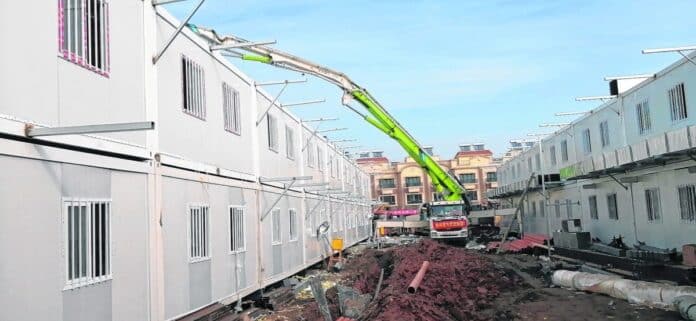
Equipment and vehicles equipped with Cummins engines were used to construct two quickly-built hospitals in China and deliver supplies as part of the country’s sweeping efforts to contain the outbreak of a new strain of coronavirus.
Huoshenshan Hospital, which was built in just 10 days this past month in the city of Wuhan, was constructed, in part, with excavators manufactured by XCMG and pump trucks made by Foton Loxa — both of which contain Cummins engines, company officials said.
Leishenshan Hospital in Wuhan, which was built in 12 days, also was constructed with Cummins-powered equipment.
The name Huoshenshan means God of Fire Mountain, according to wire reports. Leishenshan, means God of Thunder Mountain.
[sc:text-divider text-divider-title=”Story continues below gallery” ]
Wuhan, a city of around 11 million and capital of Hubei Province, has been the epicenter of the outbreak of the illness, known as COVID-19, which has infected more than 80,000 globally and caused 2,800 deaths as of Thursday, The Associated Press reported.
Cummins, which is based in Columbus and has 10 facilities in Hubei Province, also donated roughly $426,000 ($3 million yuan) to fight the epidemic and is working with the China Women’s Development Foundation to ensure the donation is used to purchase materials for medical staff, front-line workers in Hubei Province and help low-income patients.
“We were well-positioned to help in China because of our footprint and deep relationships with our Chinese partners,” said company spokeswoman Katie Zarich. “The health and safety of our employees and their families is our first priority, but we also want to support China’s efforts to fight the epidemic and contribute to the health and safety of everyone.”
The two-story, 645,000-square-foot Huoshenshan Hospital started admitting coronavirus patients on Feb. 4, according to Xinhua News Agency. The facility reportedly has around 1,000 beds and 1,400 medical staff mainly from the People’s Liberation Army, the ruling Communist Party’s military wing, according to Chinese state media.
Leishenshan Hospital reportedly has 1,500 beds and started admitting patients on Feb. 8, according to Chinese state media.
By comparison, Columbus Regional Hospital is around 622,000 square feet and has 225 beds, CRH officials said.
Huoshenshan Hospital was built by a 7,000-member crew of carpenters, plumbers, electricians and other specialists, who worked around the clock, while being live streamed by Chinese state media.
The XCMG excavators involved in the construction of the hospital included models XE200DA and XE215D, which use Cummins QSB7 engines manufactured by Guangxi Cummins, Zarich said.
Cummins’ facilities in Hubei Province have been on an extended shutdown following the Lunar New Year holiday, but are expected to reopen around mid-March, the company said.
Cummins has issued a company-wide travel ban to South Korea and parts of Italy in addition to maintaining restrictions on all employee travel in and out of China until next month.
The company travel restrictions include all of South Korea and the Lombardy and Veneto regions of Italy, including their capitals, Milan and Venice, and are expected to be in effect until March 9, said Cummins spokesman Jon Mills.
The China travel ban is expected to be in effect until March 16, Mills said.
As of Thursday, cases of the virus in China have risen to 78,497, while cases in South Korea, Iran and Italy have soared, stoking fears of a global pandemic, The Associated Press reported.
Earlier this week, U.S. health officials warned it’s inevitable the disease will spread more widely in the United States.
Currently, 26 individuals are being monitored in Indiana due to their history of travel or contact with an individual who has traveled to an affected country, the Indiana State Department of Health said in a press release.
“It’s not so much a question of if this will happen anymore, but rather more a question of exactly when this will happen, and how many people in this country will have severe illness,” said Dr. Nancy Messonnier of the U.S. Centers for Disease Control and Prevention.




